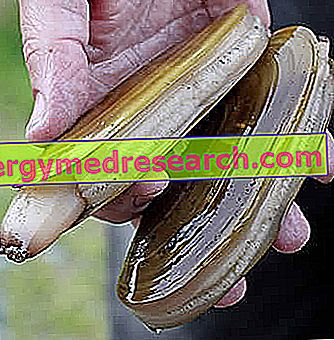What are razor clams
Cannolicchio, cappalunga and cannello are the common names of a bivalve mollusc belonging to the Solenidae family and to the genus Solen (species S. marginatus ). In reality there is not just one type of razor clam, but what we have mentioned is certainly the most widespread.

Less well known than clams, mussels and oysters, razor clams are however an integral part of the Italian culinary tradition, where they represent a very tasty ingredient for appetizers, first and second courses.
Particularly abundant on sandy and mud-mixed bottoms, they are fished and consumed above all on the eastern coast of the peninsula (bathed by the Adriatic Sea); they also colonize a part of the Tyrrhenian Sea (especially the Lazio lowland). They live sunken in the sand and are almost invisible; they feed by filtering sea water and have some natural predators consisting almost exclusively of fish.
Nutritional Properties
Razor clams are products that belong to the II fundamental group of foods. They contain few calories, mainly supplied by proteins, followed by small amounts of lipids.
Peptides are of high biological value and unsaturated fatty acids. There is not enough information on the amount of cholesterol, but it is reasonable to think that it is similar to that of clams.
Fibers and gluten are absent; if well preserved, the amount of histamine is irrelevant.
Among the minerals stands out the amount of sodium, coming from sea water, but also of the very rare iodine. Iron levels are probably also satisfactory. With regard to vitamins, we can hypothesize good concentrations of the water-soluble substances of group B. The possible presence of vitamin D cannot be excluded.
Razor clams are foods recommended in the overweight diet, since they provide less than 100 kcal / 100 g of edible portion; they are therefore hypocaloric. They are also used in food schemes for metabolic diseases, with the sole exception of sodium sensitive hypertension; in these cases it is necessary to consume them in moderation eliminating the cooking water.
They are not allowed by vegetarian, vegan and some religious regulations (such as the Muslim, kosher and Hindu).
The average portion of razor clams is 150 g of edible portion (about 120-130 kcal).
Note : the edible part of the razor clams is very low, about 1 / 3-1 / 4 of the live weight.
Tips
Tips for buying
Razor clams, like other bivalve molluscs, must necessarily be purchased alive. They are available in most Italian cities, already housed (purged) and packed in bunches of about 15-20 pieces. To check its freshness, therefore its vitality, it is sufficient to touch the foot that will have to withdraw quickly.
As we will see, razor clams can also be fished independently, but in this case it is necessary to evaluate the condition of the water and the level of pollution. By killing the razor clam during fishing, it will not only make it impossible for the animal to purge itself, but will significantly reduce its conservation.
Preparation tips
The razor clams can be cleaned from raw, opening them with a small knife at the side, on the junction of the shell, or after cooked. In both cases, especially when caught, it is essential to remove the gut. By cleaning them alive you can rinse them under running water.
After being cooked, instead, it is advisable to recover the cooking liquid by filtering it with a thin gauze and eliminating the sandy bottom. Note : like that of clams, mussels, oysters etc, this could be very salty.
Since razor clams are made of pure, fat-free muscle, they should not be overcooked or become hard and chewy. For raw consumption the source of supply is of fundamental importance; it is advisable to buy them exclusively on a regular basis by consulting the traceability label.
Recipes
Use in the kitchen
Razor clams are used in a multitude of preparations. For example: razor clam crudités, steamed razor clams (seasoned with citronette and parsley), razor clam risotto and noodles with razor clams; baked razor clams, razor clams cooked on the grill, razor clams sauté (also red and spicy) etc.
They are also a very popular ingredient in spaghetti with seafood from the upper Adriatic,

Description
Description of the razor clams
Razor clams are long-limbed bivalve molluscs, similar to a small tube, and elliptical section. They grow up to 17 cm in length and at most 3 cm in width; on the other hand, the average size of adult specimens is just over 10 x 1.5 cm.
The shells are smooth, square, thin, hard but fragile; externally, of a light yellow or light brown color, sometimes stained with black, internally they remain white, sometimes pearly. The only parts of the mollusk exposed outside the shell are:
- Above, the complex of the two siphons (the only part that emerges from the den), with which water filters to feed and breathe. These are equipped with extremely sensitive sensory organs, which intercept any change in the surrounding environment and allow predators to be anticipated
- Below, the muscular foot (like that of the clams, similar to a tongue), which allows it to dig but above all to move quickly inside the tunnels, mainly to escape. Note : the foot represents most of the edible portion of the razor clams.
Biology
Outlines of razor clams biology
The habitat of the razor clams is in the submarine subsoil, including in depths ranging from 0 to over 20 m. It nourishes and breathes by filtering the water from the ciliated siphons, with which it holds oxygen, phytoplankton and other particles. During the low spring tides, as well as the clams (above all veracious and Filipino), the various cockles, the sea hearts (cappa tonda), the Venetian casket and the mactra, even the razor clam can remain dry due to the water retreat. During these periods, which makes it more vulnerable, the razor clam survives remaining deeper (to protect itself from solar radiation and to maintain the necessary humidity). Razor clams are almost totally invisible; they remain constantly hidden inside the tunnels that dig under the sand (even more than a meter long, very useful in case of escape), exposing only the two ciliated siphons they use for filtering water outside.
To the naked eye, the razor clams are recognizable by the hole they produce in the sand, similar to an "8", which remains even when they escape in depth; on the contrary, the siphons of the clams are oval in shape, separated one from the other, sometimes of different sizes and, when they close in defensive action, they leave no empty holes.
Razor clams reproduce in spring, between April and May. They do not seem to be particularly afraid of pollution but, for unknown reasons, sometimes they disappear from areas of the sea that are also very extensive and then return in an equally mysterious manner. Some predators are feared that, in Italy, they consist mainly of fish such as: sea bream, croaker, bream, murmur, sea eagles, etc. When they remain dry, they can also be caught by some birds such as seagulls. In other parts of the planet, certain sea and non-marine mammals also feed on razor clams. If exposed, they are a welcome prey for most creatures (crustaceans, snails, etc.).
Fishing
Razor clam fishing
Razor clams are fished not only in Italy, but also abroad. On the other hand, the commercial demand for this food would not be fully satisfied if some countries, such as Spain, had not started farming.
The method of professional fishing for razor clams is exclusively by means of turbo blowers, one of the most ecologically harmful coastal fishing systems (upsetting the seabed, destroying any nest for oviparous deposition, especially of fish). At amateur and amateur level, razor clams can also be fished with 0-impact systems. The main methods are 3:
- Hand fishing: it is very difficult. It can be done in a few centimeters of water, with calm sea and low tide, bathing only the feet, or diving in apnea. It consists, once the siphons of the razor clam have been sighted, without letting it escape inside the den, in inserting two fingers (index and middle) under the sand anticipating the escape and blocking it pushing on the shell. Once stopped, insert the thumb too, grab it and extract it slowly, to prevent the foot from tearing. It can be painful and tiring for the hands, which is why few people use it.
- Fishing with iron: it's easier. It can also be done by immersing only the feet or diving in apnea. It consists of inserting a steel stick with a cone-shaped tip (similar to a dart) inside the razor clam gallery. This pierces the mollusk and, at the time of extraction, the cone locks against the shell allowing the animal to be extracted from the hole. The negative aspect of this system is that it kills the animal, not allowing it to be actively purged. At the time of preparation it is therefore necessary to open it and wash it in running water to remove sand and feces.
- Salt fishing: it is also simple but requires a high consumption of salt. This, pure or mixed in water to form a paste, during the low gushing tides that leave the razor clams in dry conditions, is poured into the animal's burrows. The razor clam, for some reason (perhaps it is an escape), emerges quickly from the den and it is possible to take it comfortably with the hands.
Disambiguation
Other species of razor clams
There is another type of razor clam that belongs to the Pharidae family, Genus Ensis and Specie siliqua (or minor ). Similar (or identical, for an inexperienced eye) to the Solen marginatus, it differs exclusively in a detail of the shell. This, instead of being of uniform color, is divided into oblique by a bisector that separates two areas (triangles joined for the bases) of slightly different appearance. For the rest, it is similar in almost all respects to the Solen marginatus .



